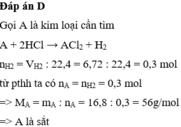Hãy nhập câu hỏi của bạn vào đây, nếu là tài khoản VIP, bạn sẽ được ưu tiên trả lời.

a) \(n_{H_2}=\dfrac{0,672}{22,4}=0,03\left(mol\right)\)
nHCl = 0,05.2 = 0,1
Có 2.nH2 < nHCl => R phản ứng hết
PTHH: 2R + 6HCl --> 2RCl3 + 3H2
____0,02<-----------------------0,03
=> \(M_R=\dfrac{0,54}{0,02}=27\left(Al\right)\)
b)
PTHH: 2Al + 6HCl --> 2AlCl3 + 3H2
___________0,06<----0,02<---0,03
=> \(\left\{{}\begin{matrix}C_{M\left(HCldư\right)}=\dfrac{0,1-0,06}{0,05}=0,8M\\C_{M\left(AlCl_3\right)}=\dfrac{0,02}{0,05}=0,4M\end{matrix}\right.\)

mik sửa lại cái dưới bị lỗi latex
\(a.n_{HCl}=0,05.2=0,1\left(mol\right);n_{H_2}=\dfrac{0,672}{22,4}=0,03\left(mol\right)\\ 2R+6HCl\rightarrow2RCl_3+3H_2\\ \Rightarrow\dfrac{0,1}{6}>\dfrac{0,03}{3}\Rightarrow HCl.dư,R.pư.hết\\ n_R=0,03.2:3=0,02\left(mol\right)\\ M_R=\dfrac{0,54}{0,02}=27\left(g/mol\right)\\ \Rightarrow R=27\left(Al,nhôm\right)\\ b.C_{M_{AlCl_3}}=\dfrac{0,3.2:3}{0,05}=0,4M\\ C_{M_{HCl\left(dư\right)}}=\dfrac{0,1-\left(0,3.6:3\right)}{0,05}=0,8M\)
\(a.n_{HCl}=0,05.2=0,1\left(mol\right)\\ n_{H_2}=\dfrac{0,672}{22,4}=0,03\left(mol\right)\\ 2R+6HCl\rightarrow2RCl_3+3H_2\\ \Rightarrow\dfrac{0,1}{6}>\dfrac{0,03}{3}\Rightarrow HCl.dư,R.pư.hết\\ n_R=0,03.2:3=0,02\left(mol\right)\\ M_R=\dfrac{0,54}{0,02}=27\left(g/mol\right)\\ \Rightarrow R=27\left(Al,nhôm\right)\\ b.n_{AlCl_3}=n_{Al}=0,02mol\\ C_{M_{AlCl_3}}=\dfrac{0,02}{0,05}=0,4M\\ C_M_{HCl\left(dư\right)}=\dfrac{0,1-\left(0,03.2\right)}{0,05}=0,8M\)

Thể tích dung dịch HCl dùng cho cả 2 phản ứng bằng nhau, nên có cùng số mol. Kí hiệu X, Y là khối lượng mol nguyên tử của 2 kim loại.
Phương trình hoá học của phản ứng :
2X + 2nHCl → 2X Cl n + n H 2 ↑
n H 2 = 0,672 /22,4 = 0,03 mol
Theo đề bài: 0,06/n x X = 1,95 → X = 32,5n
Kẻ bảng
| n | 1 | 2 | 3 |
| X | 32,5 | 65 | 97,5 |
Vậy X là Zn
Y 2 O m + mHCl → Y Cl m + m H 2 O
Theo đề bài, ta có:
(2Y + 16m) = 1,6 → Y = 56/3.m
Kẻ bảng
| m | 1 | 2 | 3 |
| Y | 56,3 | 112/3 | 56 |
Vậy Y là Fe.

tham khảo
Coi mdd H2SO4=100(gam)mdd H2SO4=100(gam)
⇒nH2SO4=100.9,8%98=0,1(mol)⇒nH2SO4=100.9,8%98=0,1(mol)
Gọi CTHH của muối cacbonat kim loại R hóa trị n là R2(CO3)nR2(CO3)n
R2(CO3)n+nH2SO4→R2(SO4)n+nCO2+nH2OR2(CO3)n+nH2SO4→R2(SO4)n+nCO2+nH2O
Theo phương trình ,ta có :
nCO2=nH2SO4=0,1(mol)nCO2=nH2SO4=0,1(mol)
nR2(SO4)n=nR2(CO3)n=nH2SO4n=0,1n(mol)nR2(SO4)n=nR2(CO3)n=nH2SO4n=0,1n(mol)
Sau phản ứng ,
mdd=0,1n(2R+60n)+100−0,1.44=0,2Rn+101,6(gam)mdd=0,1n(2R+60n)+100−0,1.44=0,2Rn+101,6(gam)
mR2(SO4)n=0,1n(2R+96n)=0,2Rn+9,6(gam)mR2(SO4)n=0,1n(2R+96n)=0,2Rn+9,6(gam)
⇒C%muối=(0,2Rn+9,6):(0,2Rn+101,6).100%=14,18%⇒C%muối=(0,2Rn+9,6):(0,2Rn+101,6).100%=14,18%
⇒R=28n⇒R=28n
Với n=1n=1 thì R=28R=28(loại)
Với n=2n=2 thì R=56(Fe)R=56(Fe)
Với n=3n=3 thì R=84R=84(loại)
Vậy kim loại R hóa trị n là FeFe hóa trị II

2R+2nHCl\(\rightarrow\)2RCln+nH2(1)
Ta có nH2=\(\frac{0,672}{22,4}\)=0,03(mol)
m tăng=mR-mH2
\(\rightarrow\)mR=4,05+0,03.2=4,11(g)
\(\rightarrow\)MR=4,11:0,06/n=68,5n
\(\rightarrow\)n=2 và MR=137
\(\rightarrow\)R là Bari
b) Ca(OH)2+2HCl\(\rightarrow\)CaCl2+2H2O(2)
nCa(OH)2=\(\frac{\text{50.3,7%}}{74}\)=0,025(mol)
nHCl=nHCl(1)+nHCl(2)=0,06+0,05=0,11(mol)

\(n_{H_2}=\dfrac{1,344}{22,4}=0,06\left(mol\right)\)
PTHH: 2R + 3H2SO4 --> R2(SO4)3 + 3H2
____0,04<----0,06-------0,02<------0,06____(mol)
=> \(M_R=\dfrac{1,08}{0,04}=27\left(g/mol\right)=>Al\)
\(C_{M\left(H_2SO_4\right)}=\dfrac{0,06}{0,05}=1,2M\)

a) nH2=0,0672/22,4=0,03(mol)
2R + 6HCl->2 RCl3 + 3H2
0,02<-.................0,02.<-0,03 (mol)
R=0,54/0,02=27
=> R là Al
b) CMddAlCl3=0,02/0,5=0,04M